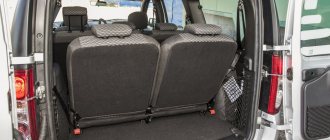What is the carrying capacity of the Lada-Largus: comparison with competitors
The certified carrying capacity of all modifications of the Lada Largus, calculated as the difference between the curb and gross weights of the vehicle, has the following values:
- 445 kg for a 5-seater station wagon;
- 480 kg for the 7-seater version and for Largus Cross;
- 750 kg for a van.
Undoubtedly, the characteristics are impressive for a B-class family car, and the Largus van is comparable to the capabilities of representatives of the commercial LCV segment, such as the GAZ-2752 Sobol.
However, considering cargo capabilities only in terms of payload is not entirely correct. After all, humanity invented trucks to transport cinder blocks and floor slabs. And for a typical station wagon owner, the most important thing is to answer the question of whether he can carry ten packs of insulation at a time, and whether a two-meter refrigerator will fit into the cabin.
Therefore, it is possible to more objectively assess the cargo capabilities of the Lada Largus based on the volume of the luggage compartment and its dimensions (depth, width and height).
In addition, we should not forget about the price component: the Audi allroad station wagon with a three-liter engine has a comparable maximum load capacity of 500 kg, but the cost is equal to 8.5 Largus.
About the car
With impressive cargo compartment dimensions, the Lada-Largus van is a practical domestic vehicle based on the B0 platform. By its nature, this is a Renault Logan Van, released in 2006, on which specialists simply changed the emblem and performed some modifications. The Lada-Largus is perceived as a workhorse, which will appeal to both avid lovers of trips to the countryside and entrepreneurs who specialize in small cargo transportation.
Volume and dimensions of the luggage compartment of the Largus family
So, we present the contenders for the championship title in the category “The most spacious trunk for 500 thousand rubles”:
The 5-seater Lada Largus with a load capacity of up to 445 kg, according to official information from AvtoVAZ, has a luggage compartment with a volume of 560 liters. With the rear row seats folded down, 2,350 liters of usable space are available to accommodate cargo.
The linear dimensions of the compartment have the following values:
- Trunk length 90 cm or 174 cm (to the level of the backs of the front seats);
- Actual compartment width 134 cm;
- The height of the rear door opening is 92 cm.
In the 7-seater modification of the Lada Largus, the load capacity declared by the manufacturer is increased by 35 kg compared to its 5-seater brother due to the reinforced suspension. The trunk is designed for 135 liters of cargo. By folding the backrests of the third row of seats, you can increase the luggage volume to 560 liters. A maximum capacity of 2,350 liters is provided when all rows of seats except the first are folded down. The Lada Largus Cross also shows similar load capacity parameters.
The following video describes the procedure for dismantling the right-side seats for transporting cargo over two meters long:
Warning! Stowing cargo above the openings of the side and rear windows seriously impairs visibility. Be careful when driving so as not to get into an emergency situation.
Another unique modification of Largus is a van, suitable for transporting small quantities of various goods or for use as a traveling vehicle for repairmen, builders and other technical services.
The Largus cargo van has a load capacity of up to 750 kg. The length of the luggage compartment is 194 cm at floor level; at roof level the size is reduced due to the shape of the cabin partition. The floor distance between the rear wheel arches is 96 cm, the actual width of the cargo compartment is 134 cm. The width of the side door opening is about 61 cm.
Reminder! Unless absolutely necessary, you should not exceed the maximum load capacity established by the manufacturer, even if the luggage compartment space allows it. In this case, there is a high probability of damage to the vehicle’s suspension elements.
Increasing the volume of the cargo compartment (removing the excess part on the floor)
The cargo compartment volume of the Lada Largus van can be increased. To do this, remove the floor covering.
There are two types of fasteners here
We will need special Torx keys, without which the screws cannot be unscrewed: Torx T30 and T40.
Study the picture carefully:
- T40 caps (2) are located at the corners, as well as on the line between the arches;
- The remaining screws (1) are designed for Torx T30 keys.
Removing the trim will be easy. And when you install it, make rubber gaskets. They are fixed to the ends of the frame so that the casing does not rust.
The removable floor (cladding) consists of two halves - left and right. First, according to tradition, the right one is removed.
Domestic B-class competitors
Among the products of the Russian automobile industry in the station wagon body are the Lada Priora and Lada Kalina 2 cars.
For the Lada Kalina 2 (VAZ 2194), the name “station wagon” rather informs about the body type than indicates serious load-carrying capacity. The luggage compartment capacity is 355 liters (with the rear row of seats folded - 670 liters), which is comparable to that of full-size sedans. Based on the dimensions of the Kalina platform, the linear dimensions of the luggage compartment are also very modest.
The secret of increased performance
Currently, manufacturers of Lada Largus cars indicate in the technical documentation attached to it the dimensions of their fuel tank, equal to approximately 50 liters. In fact, you can put a lot more gasoline into it. There are several reasons for this:
- relatively large fuel tank neck;
- deliberate application of a slightly smaller volume by manufacturers to comply with technical documentation;
- the presence of special voids in the tank that increase its level of wear resistance;
- errors in the operation of refueling equipment.
About the long neck
Naturally, the creators of the Lada Largus car, if possible, would indicate exactly 65 liters of fuel in the technical parameters, if they had such an opportunity. In fact, almost any car can be filled with slightly more gasoline than is indicated in the documentation. This is due to the fact that not the entire actual volume of the fuel tank is subject to accounting. The fact is that the neck is not an accounting space. At the same time, in the Lada Largus car it has increased dimensions in comparison with other models. As a result, several liters of fuel will easily fit there.
Fuel system Lada Largus
Better to play it safe
Another important point to understand is the fact that manufacturers indicate not the exact, but the approximate volume of the fuel tank. Moreover, in reality, in no case should it be smaller in size than what is written in the application from the manufacturer. It is for this reason that companies play it safe and indicate a slightly smaller fuel tank volume.
All gas stations lie
We should also not forget that unscrupulous gas stations can “increase” the amount of fuel they can hold without any problems. In fact, there are even officially indicated “miscalculations” of equipment during the process of pouring gasoline into a car. Most often we are talking about 50 ml per 10 liters. What can we say about unofficial “mistakes”.
Safety first
Another reason for such differences should be sought in the physical properties of gasoline itself. The fact is that during the heating process it expands quite strongly. So, if the fuel tank does not have additional volume, it can lead to failure. It is to avoid such excesses that any tank has special hollow protrusions. Under normal conditions, after firing the refueling nozzle, they are still empty. If you wait a little and try to continue refueling, these reserve spaces will also be filled.
Foreign cars with comparable carrying capacity
If it is difficult to find a car with similar characteristics among ordinary station wagons, you should turn to neighboring classes.
5 and 7-seater options with a spacious trunk are typical for the MPV class, which unites minivans and high-capacity station wagons. Among the typical representatives are Renault Kangoo, Peugeot Partner, Fiat Doblo, Skoda Roomster, Volkswagen Caddy.
Without focusing on the significantly higher cost of these vehicles, we will conduct a comparative analysis of their cargo capabilities:
- Renault Kangoo is available as a 5-seater minivan with a payload of 451 kg and a van with a payload of 592 kg. Luggage compartment volume ranges from 660 liters as standard to 1,524 liters for vans and minivans with the rear seats folded down.
- The Skoda Roomster is designed for 5 seats and can accommodate from 450 to 1555 liters of luggage weighing 455 kg.
- Peugeot Partner in minivan format (5 seats) with a luggage compartment of up to 2800 liters and in a van modification of up to 2830 liters can carry up to 600 kg of luggage.
- Volkswagen Caddy for 5 or 7 passengers takes up to 665 kg of cargo in the trunk. The volume of the compartment, depending on the configuration of the seats, ranges from 750 to 3300 liters. The Caddy Maxi van with an extended wheelbase has a luggage compartment volume of 4.2 m3.
Station wagon, minivan and van - are there any differences inside the cars?
Many car enthusiasts know that the Lada Largus is available in three body styles: station wagon, minivan and van. The options do not have any special differences, except for one “but” - they have a different number of seats:
- The standard station wagon has 5 seats and a medium-sized trunk (560 liters).
- The extended station wagon, also known as a minivan, has 7 seats and a small trunk (170 liters).
- The van has only 2 seats - one for the driver, the other for the front passenger. This Largus variation has an extended trunk (about 2000 liters), which is needed for transporting large cargo.
Apart from the number of seats, there are no differences in the interior design of all variants of the Lada Largus. The general concept of the interior is determined based on the selected configuration:
- in cars with a budget set of options, the interior has an “economy class” character, featuring standard AvtoVAZ upholstery: fabric seat covers and a lot of plastic;
- in models with a more “advanced” set of options, the interior is necessarily complemented by leather upholstery of the steering wheel, seats and some parts of the interior upholstery; in addition, in the interior design you can find various multimedia additions and upgraded components of standard equipment.
Important! The general interior concept for all variations of the Lada Largus is the same. The final design format is determined not by the chosen body option, but by the specific configuration.
Modifications of Lada Largus van
| 1.6 l Renault K7M 84 hp 124 Nm and 5-speed Renault JH3 |
| 1.6 l Renault K4M 102 hp 145 Nm and 5-speed Renault JR5 |
| 1.6 l VAZ 11189 87 hp 140 Nm and 5-speed Renault JR5 |
| 1.6 l VAZ 21129 106 hp 148 Nm and 5-speed Renault JR5 |
AvtoVAZ promised to soon replace the Renault gearbox with the domestic VAZ 21809.
We have a separate and very detailed material about all Largus power units
For several years now, this van has been tested in the park of ZaRulem magazine.
ARTICLE
A detailed description of this car can be found on the Largus-MCV portal
PDF
On the manufacturer's website you can download the current user manual
Rear cabin
Of course, the front part of the cabin of any car is more interesting to consider, since it is a kind of transport control center. Despite this, when studying the interior of the Lada Largus, it would be a crime to ignore a detailed examination of the rear of the cabin. To be fair, we note that there is something to see here too.
To begin with, let us remind you that in Largus the rear part of the cabin can be:
- or 5 armchairs (three and two of them are made as separate solid sofas);
- or 3 armchairs (made as a solid sofa);
- or a regular luggage compartment with a large capacity.
A pleasant difference between any organization of the rear part of the interior of the Lada Largus is that it is quite spacious. Moreover, any owner of this model, if desired, can remove the rear seats and personally turn his car into a van. Photos of the Lada Largus interior with 5 seats and 7 seats illustrating this concept are presented below.
The rear seats in Largus have comfortable head pillows for passengers, integrally built into the seat frame. There are standard seat belts on the sides of each seat. The rear doors are required to have armrests. In addition, the rear part of the cabin is filled with a considerable number of pockets, cup holders and similar containers for passengers’ belongings, which is simply good news.
The specific interior design in this area of the car is also determined based on the selected configuration of the Lada Largus and is similar to the front part (see photo below).
Important! The rear part of the cabin in Largus does not have any specific features, but it is made of very high quality and competently, which allows passengers to move comfortably in the car and behind it.
Largus Van interior
The interior of the cargo-passenger Largus is designed to seat two people (driver and one passenger) and is equipped with seats with mechanical adjustment in four directions. What else can be noted in the car interior:
- the steering column is adjustable, but only in height;
- the chairs are generally comfortable, but with insufficiently rigid backrests;
- the ceiling in the cabin is high, there is more than enough headroom;
- the instrument cluster has speedometer and tachometer dials on the sides, a small monochrome display occupies the middle position;
- almost all control elements (keys for power windows, central locking, emergency lights, handles for air conditioning and heating systems) are located centrally on the dashboard or on the center console, there is also a 12-volt socket;
- steering wheel - three-spoke, without keys;
- there is no interior mirror;
- The interior door panels are made of hard plastic.
The seat heating buttons are installed on the sides of the seats themselves, on the door side, but in the poorest configuration they will not be there, as well as the ESP buttons. The air ducts on the dashboard are round in shape; in appearance they resemble deflectors from a Gazelle.











